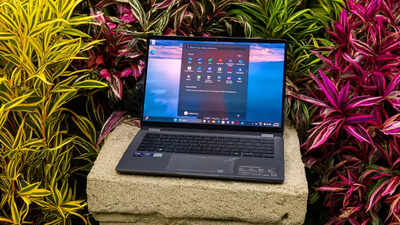- News
- Technology News
- Reviews
- Asus Vivobook Flip 14 (2025) laptop review: Adds flexibility to work
Trending
Asus Vivobook Flip 14 (2025) laptop review: Adds flexibility to work
Asus Vivobook Flip 14 (2025) offers a versatile design for work and entertainment at Rs 96,990. Highlights include a 14-inch OLED touchscreen, a sturdy 360-degree hinge, and a range of ports. Powered by an Intel Core Ultra 7 processor with a 16GB RAM, it handles multitasking smoothly.
Rating: 3.5/5
From productivity-focused devices to powerful gaming rigs, has consistently delivered innovative laptops across various segments. The brand recently expanded its lineup of 2-in-1 laptops with the Asus Vivobook Flip 14 (2025). This new laptop offers a versatile convertible designed for both work and entertainment.

Design
The first thing we noticed after unpacking the Asus Vivobook Flip 14 (2025) was how sturdy it looked. Weighing at 1.5kg, it felt a little heavy but the weight was so well distributed that we could easily balance it on one hand, making it instantly clear that portability was a priority in its design.
The sleek metal chassis gave it a premium feel, and the matte finish on the lid looked sophisticated and resisted fingerprints surprisingly well—something we appreciated after a full day of use.

Opening the lid was seamless, courtesy of the 360-degree hinge, which struck the perfect balance between sturdiness and flexibility, allowing effortless transitions between modes. We naturally shifted between laptop mode for work, tent mode for binge-watching, and tablet mode for casual browsing.
The hinge provided just the right amount of resistance—it wasn’t too tight, making it easy to flip, yet firm enough to hold its position without wobbling. One small but thoughtful detail we loved was how the display automatically adjusted to tablet mode once the hinge passed 180 degrees, making the transition feel seamless.

The 14-inch touchscreen display struck an ideal balance, offering ample space for productivity while preserving a sleek and compact design. We especially enjoyed using the tablet mode for sketching and taking notes, and while the glossy finish attracted some reflections under bright light, the touch response was smooth and responsive. More details about the display will be discussed below.

As for ports, Asus didn’t cut many corners on connectivity. The left side houses a USB Type-A port, while the right side featured a full-sized HDMI 2.1, a Thunderbolt 4 USB-C port, another USB-C (USB 3.2 Gen 2), a microSD card slot, and a 3.5mm audio jack. The variety of ports meant we rarely had to rely on adapters, which was a huge plus when juggling accessories like external monitors or USB drives.
Keyboard and trackpad
Let’s talk about the keyboard, trackpad, and webcam. No matter how good a laptop looks or performs, if typing feels uncomfortable or navigating the screen is a hassle, it can take away from the experience. Luckily, Asus has put some thought into these essentials, and it shows.

The ErgoSense keyboard feels instantly familiar and comfortable. The 1.7mm key travel gives each keystroke a nice, tactile bounce, making typing feel natural and responsive. The keys are well-spaced, so we never find ourselves hitting the wrong ones by accident. After hours of typing out documents and emails, there was no finger fatigue, which is always a good sign.
The backlighting came in handy during late-night work sessions. It’s bright enough to make each key visible in dim lighting but not so intense that it feels distracting. There’s even a dedicated Copilot key for quick access to AI features. It’s a nice addition for those who rely on AI-powered tools, but it’s not a game-changer.
The large trackpad is another highlight. It’s smooth to the touch, thanks to a special hydrophobic coating that prevents smudges and keeps it responsive even after hours of use. Scrolling through documents and webpages felt effortless, and gestures like pinch-to-zoom and three-finger swipes worked flawlessly.
We found the smart gestures on the trackpad one of the coolest little features �?swiping along the right edge adjusts brightness while swiping along the left controls volume. It took a little getting used to, but once we did, it felt incredibly intuitive. No more fumbling with function keys just to tweak screen brightness.
Display and audio

Watching movies on this display was a delight. The 14-inch Full HD+ (1920x1200) panel delivered deep blacks, punchy colours, and sharp details, making every scene feel immersive.
While watching movies like Venom: The Last Dance or Shazam on Netflix, we observed that dark scenes showcased deep, rich contrasts, while bright landscapes burst with vivid vibrancy. The inclusion of a 100% DCI-P3 colour gamut and DisplayHDR 500 True Black certification further elevated the overall visual experience.
Working in different lighting conditions was also quite comfortable, thanks to the 500 nits of peak brightness. Indoors, we rarely needed to push it past 70%, and even in a café with sunlight streaming in, bumping it to full brightness kept everything readable. That said, the glossy finish made it a bit tricky when sitting near a window, as reflections could sometimes be distracting.
Flipping the laptop into tablet mode made us appreciate the touchscreen even more. Whether jotting down quick notes with the Asus Pen 2.0 or casually scrolling through articles, the touch response was precise and fluid. It felt natural, almost like using a high-end tablet, though we did have to keep a microfiber cloth handy to wipe off fingerprints.

A great display also deserves equally good sound, and the dual speakers with Smart Amplifier technology and Dolby Atmos didn’t disappoint. The speakers got surprisingly loud, filling up a small room easily without distortion. Dialogue in movies sounded clear, and background music had a decent amount of depth.
We played Hans Zimmer’s "Time", and the subtle buildup of instruments was handled well, though bass lovers may wish for a bit more punch.
What stood out was the spatial audio effect when using headphones. Watching movies with Dolby Atmos felt incredibly immersive, with directional sound making action sequences feel more dynamic. However, we noticed some distortion ("crackling sound") when playing media at maximum volume, which affected the listening experience.
Performance and AI features
Now, let’s come to the part that makes or breaks the whole laptop experience—its performance and software. After all, a sleek design and great display don’t mean much if the laptop struggles with everyday tasks. Thankfully, the Vivobook Flip 14 (2025) delivers a smooth and reliable experience, whether we’re working, streaming, or even some light gaming.

Powered by the Intel Core Ultra 7 processor and paired with 16GB of LPDDR5X RAM, the laptop handled everything we threw at it with ease. Whether we were juggling multiple Chrome tabs, editing images in Photoshop, or streaming videos in 4K, the performance remained buttery smooth. Even with YouTube running in the background, Spotify playing music, and a couple of Word documents open, there were no slowdowns or stutters.
One thing we noticed is that the laptop wakes up almost instantly when opening the lid, which makes getting back to work feel seamless. Apps launch quickly and even large files load without frustrating delays.
Heat management is also on point—after hours of usage, the chassis got warm but never uncomfortably hot, even when we were multitasking heavily.
While the Intel Arc Graphics isn’t built for hardcore gaming, we still managed to enjoy a few rounds of Valorant and Rocket League on medium settings. Valorant ran at a consistent 200fps, and Rocket League stayed well above 60fps, making for a smooth experience.
GTA V ran smoothly on medium settings, although we observed occasional frame drops during scenes with higher graphical intensity. That said, the fan noise does kick up a bit during gaming sessions, but it’s not distracting. The heat also stays well under control, so we didn’t have to worry about an uncomfortably hot keyboard while gaming.
The Vivobook Flip 14 (2025) runs Windows 11 with a handful of AI-powered features that aim to enhance productivity. With a dedicated Copilot key, accessing AI assistance is just a tap away. We tried using it for quick file searches, summarising notes, and answering queries, and while it worked, we didn’t find ourselves relying on it as much as expected. It’s a nice-to-have feature, but not essential for everyday tasks.
The Asus StoryCube AI-powered photo management tool automatically organises photos and even enhances them using AI. It came in handy when we needed to quickly sort through hundreds of shots from the TOI-Gadgets Now Awards 2025 event, and the auto-enhancement feature did improve a few low-light shots.
The Full HD IR camera also does a solid job for video calls. In well-lit rooms, the picture quality was crisp and clear, with good colour reproduction. Even in lower lighting, it didn’t turn us into grainy silhouettes.
What truly stands out is the Windows Hello facial recognition feature. The IR sensor makes logging in as simple as looking at the screen. Even in dim lighting, it worked flawlessly and quickly, saving us the hassle of typing in passwords.
The laptop also uses AI to improve video calls with features like background blur, eye-contact correction, and noise cancellation. We tested this during a Google Meet call, and the background blur was impressively smooth, making us stand out clearly. Noise cancellation worked great too and was able to block out the hum of a ceiling fan.
Battery
Finally, the laptop’s battery—something we all care about. With its 70Wh battery, the laptop easily lasted us through a full workday without breaking a sweat. Our typical day involved a mix of writing, web browsing, watching YouTube videos, and occasional video calls, and we rarely felt the need to plug in before the end of a workday.
Even after 8 hours of multitasking—jumping between Chrome tabs, editing documents, and streaming music—we still had enough battery left to wind down with an episode of our favourite show.
When we pushed it harder, like playing a few rounds of Valorant or editing photos in Photoshop, the battery drained more quickly, but that’s expected. Even then, it didn’t feel like we were rushing to find a charger within a couple of hours.
One standout feature of the Vivobook Flip 14 (2025) is its impressive charging speed. With the 65W USB-C charger, we could go from zero to 50% in about 40 minutes, which meant we never had to worry about running out of juice during a short break. A quick charge while grabbing coffee was often enough to power through the rest of the day.
Plus, the USB-C charging makes things more convenient—we were able to use the same charger for our phone, which meant one less cable to carry around.
Verdict
The Vivobook Flip 14 (2025) proves to be a versatile and well-optimised machine that blends performance, portability, and smart AI features into a sleek and reliable package in a Rs 1 lakh budget. Whether we were powering through work, enjoying multimedia, or even indulging in some casual gaming, the laptop handled it all with ease.
From its vibrant OLED display and immersive speakers to its snappy performance and dependable battery life, every aspect feels thoughtfully designed. The comfortable keyboard, spacious trackpad, and responsive touchscreen make everyday use a pleasure, while the solid webcam with facial recognition adds convenience for seamless logins and video calls.
What stands out most is how effortlessly the Vivobook Flip 14 (2025) adapts to different needs. It’s fast enough for productivity, flexible enough for entertainment, and efficient enough to last through a full day without battery anxiety. Whether you’re a student, a professional, or a creative, this laptop feels like a reliable companion that gets the job done—without compromises.
End of Article
Latest Mobiles
FOLLOW US ON SOCIAL MEDIA










